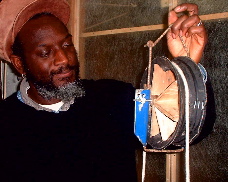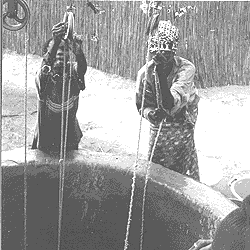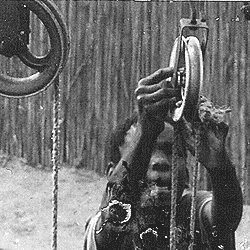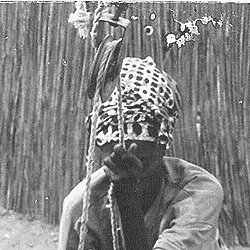
The use of a pulley to lift water from a well is a great improvement over having to lift a bucket with water on a rope with your arms stretched out in front of you. In Gambia there were farms and gardens abandoned because the water table had sunken too deep. To lift water from these wells in sufficient quantity to water the garden had become too heavy a task.
As the pulley cannot always be left at the site of the well to prevent theft, such a pulley should be light in weight as to make it easy to take it home. It should be robust, take rough handling such as smashing it against a wall or the floor. It should run accurate with little friction. As indispensable for productive working, it should be easy to repair, even during use in the field.
The pulley is in the very beginning of its development. At Demotech there is already loads of new info, even on this simple device. Demotech invites initiatives to port the latest info to this page, but easier is it to surf to http://www.demotech.org/d-design/designA.php?d=55 And more will come out of it if you join our research at Demotech!
How
The construction of the pulley is meant to be appropriate for manufacture in a village.
- The rim of a pulley can be cut from used car tires.
- The hub is made of wood and not from steel to promote manufacture in village handicraft.
- A method of construction is developed that needs no fasteners. All composing parts stay together because of being mounted with pretension.
- An easily applicable method takes care for cutting the spokes to the accurate size that ascertains running without any wobbling.
- The bearing of the pulley consists of two steel pins driven into the center of the wooden hub, running into some windings of rope, attached to the supporting frame construction. Because the pin has a small diameter and because of steel and plastic match well as bearing materials, the pulley runs very smooth and light.
- Any wear on this bearing is simply repaired by winding a little more rope from the frame around the bearing pins of the pulley.
The development of this method of pulley construction and manufacture is done in cooperation with a rural project in Senegal, managed by the Foundation "Keur Mousse".
Pulleys as they are normally used in West Africa

Each woman brings her own pulley, rope and bucket when fetching water from a communal well. The pulley is hooked to a beam, positioned over the well. To attach her pulley she has to lean against the superstructure of the well. The area around the well may be muddy and slippery, so this can be dangerous. The working position when hauling water is leaning against the well with the lower body or the legs. The downward part of the rope runs into the well. To speed up getting water from the well, sometimes (i.e. in Indonesia) a small container or water bag is attached to each end of the rope.
Pulleys as they function normally

This woman has just hooked her pulley to the support over the well. Now she works on laying the rope over the pulley wheel. There is no guide to keep the rope into the groove, so the rope can fall off when the pulley is carried around. But in actual use this is not a problem, as the groove is deep enough and the sides of the groove are smooth. Pulleys can be bought at the local market in different sizes, the other woman uses a pulley with a smaller diameter wheel.
Detail of the problem with pulleys

This detail of the first picture shows the main problem with the traditional pulley: they wear out too quickly for the money they cost, even when locally made and marketed. The wear is caused by the use of a steel pin as an axle, running in a (cast) steel pulley wheel. This causes fretting, indicated by its well known squeaking. Because of wear the axle gets thinner, not guiding the wheel properly. The wheel sags to one side and starts rubbing the frame, causing more friction and faster wear, then it will soon fall apart and is beyond repair. Separate pulley wheels, used for other purposes around the well, indicate this is a common problem.
The prototype pulley for Senegal

The first prototype developed by Demotech, shown here by Ives Faye. Ives and Reinder took this prototype to Senegal in February 2003. It inspired at the intended test location in Keur Mousse a similar pulley with a larger diameter.